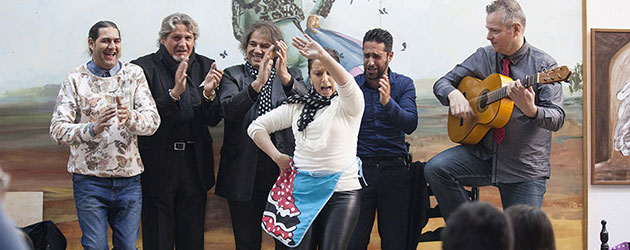Silvia Cruz Lapeña
Photos: Ana Palma
The flamenco association baptized with the name of the gypsy singer opens every day to remember «the most Bohemian flamenco» of Jerez de la Frontera.
Special 21 Festival de Jerez – All the information
La noche se viste de corinto The night dresses in purple
y yo me visto de hombre and I become more a man
y tú, de los besos míos. and you dress in my kisses
These are the verses Luis de la Pica scribbled down and sang in Jerez de la Frontera shortly before his death. “He was like a child, I remember he went about his things, never messing with anyone, without talking to anyone, always so special”. That’s Rocío Jiménez speaking, of the Peña Luis de la Pica, an association she has been running, along with her husband, Juan Castro, since three years ago. At the center, located in an old school on Carpinteros street, there is a poster that announces the day’s performances. “But as you can see, the reality has little to do with any poster”, laughingly says Ulrich Gottwald, a guitarist from Munich, who is waiting for the singer he came to accompany to finish his game of cards.
Gottwald, known as “El Rizos”, has visited Jerez every year since 2001, and at 50 feels he took too long to find flamenco, and this place where it thrives. “I was playing violin, but at 17 I discovered the flamenco guitar…much too late to be a good player, but as soon as I heard it, I knew it was for me.” Paco de Lucía and Sabicas were to “blame” for his having four records on the market, and that he dares to do something not many would attempt: to accompany Jerez street singers, not on stage, but the ones formed in informal gatherings, unpredictable, doing things their own way, not going by anyone’s rules. The moment to show off their talents comes minutes after speaking with Deflamenco, when Nacho Fajardo goes on to sing, and the German guitarist accompanies him in martinete, bulería and whatever else comes along, while the audience, made up of foreigners, locals, young and old, applauds and savors a moment that won’t be repeated.
“That’s the charm of it all, that things happen here that aren’t planned, you don’t know what’s going to happen. You come one day, and old Fernando de la Moreno, or Diego Carrasco are whooping it up. And they’re in no hurry to leave!” explains Rocío, who is from the family of Paquera. Both she and her husband have jobs: she’s a cook, and he works in construction, although he used to be a singer. “It’s in the genes, and that’s why we almost spend more time at the peña than doing anything else” says the young man, who was involved in creating the association with a group of friends eleven years ago. The same ones his daughter Manuela has, who listen to her so attentively. “I like this because I meet people, and I love it!” declares the young girl, who knows de la Pica’s verses by heart. “We decided to name this after Luis de la Pica, because he was very special, and he represents the most Bohemian flamenco of Jerez de la Frontera. He was our idol!” explains Jiménez about the singer born on the De la Sangre street.
No closing time
José Monge “Macarra”, of the Sordera family, is also singing today, with guitarist Diego del Morao in the audience. It’s raining outside, and a lot of people have preferred not to make the rounds of the flamenco clubs on a day which is already the half-way point of the Festival de Jerez. Nacho Fajardo also gets underway, and gets the gypsies out of their seats with his siguiriya flourish. It’s still daytime, 5 in the afternoon, and yet the atmosphere is warming up at this club open to the public, not only for members. And it’s open every day, something you don’t see in other establishments of this type. Its president, Juan, has just gone up on stage to keep rhythm for “Macarra”. Rocío, who says she’s “a little embarrassed to dance”, also ends up doing her little bulerías dance, while Manuela watches them, enthralled, and records them with her mobile phone.
Once everyone is off the stage, the party continues on the floor, and it becomes clear the moment has arrived to decide: to stay, or to go, taking into account that staying means not knowing when it would be polite to leave, especially considering that later on Manuel Soto “El Bo” is expected to show up. This artist, being a professional of the rhythm makes him a classy but secondary player in the theater, but an emperor in Jerez, someone for whom a young Chinese man drinking manzanilla wine at the Luis de la Pica club, wearing a guitar strapped to his back, perks up when he hears that name. “Do you see why we don’t have to program anything?” says Jiménez gesturing to the improvised singers and dancers who have joined the party. The only thing that’s prepared and rehearsed here is Noches de Corinto, a day celebrated in August in honor of their idol. “This place is very much in his line, he would have loved it. I remember when his mother used to go out looking for him because he would be gone for days partying. ‘Have you seen my Pica’? she would ask everyone in the street. I lived in front of their house, I always admired him”.
To go or to stay, that is the question. To change to another place and atmosphere, or get caught up in the loop these gypsies just formed. Because at the Luis de la Pica club, there’s no closing time, but perhaps on the same wave-length, the clock also stops when the flamenco gets started.
